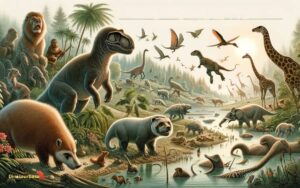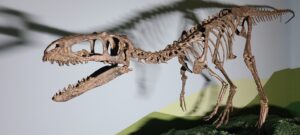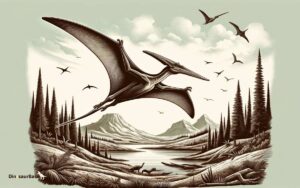Are Dinosaurs Birds or Reptiles
Opening Pandora's box, the question of whether dinosaurs are birds or reptiles takes center stage in the scientific community. Researchers scrutinize fossil evidence, examining reptilian characteristics and avian connections, to untangle this evolutionary knot.
The Archaeopteryx, with its blend of dinosaur and bird features, serves as a fulcrum in this debate, challenging long-held views. As one delves into genetic insights and modern descendants, the lines between dinosaurs' identities blur, suggesting a more complex evolutionary pathway than previously thought.
This enigma invites further exploration, promising revelations that could reshape our understanding of life's ancient tapestry.
Key Takeaways
- Dinosaurs exhibit both reptilian and avian characteristics, complicating strict classification.
- Theropod dinosaurs, due to shared genetic and physical traits, are direct ancestors of birds.
- Fossil evidence, such as feathers and nesting behaviors, supports the evolutionary link between dinosaurs and birds.
- Scientific classification is fluid, reflecting ongoing discoveries that reshape our understanding of dinosaurs' place in natural history.
The Dinosaur Discovery
The first recorded discovery of dinosaur fossils, igniting centuries of scientific analysis and debate, dates back to the early 19th century. This period marks the genesis of paleontology as a distinct scientific field.
Researchers initially grappled with the realization that these colossal skeletal remains belonged to creatures that no longer roamed the Earth. The initial findings were fragmented and often misinterpreted, leading to speculative reconstructions. However, as methodologies advanced, so did the accuracy of dinosaur representations.
This era laid the foundational understanding of dinosaurs as a diverse group of prehistoric animals. It steered clear of the simplistic categorizations of earlier times, emphasizing the complexity and variety within these ancient beings.
This discovery phase was crucial, setting the stage for subsequent debates on the evolutionary lineage and classification of dinosaurs.
Reptilian Characteristics
When examining the reptilian characteristics of dinosaurs, the texture of their skin and scales emerges as a primary feature. These creatures exhibited a variety of skin textures, often resembling that of modern reptiles, which supports the argument for their classification within the reptile family.
Moreover, the debate around their cold-blooded physiology further aligns them with reptilian traits, suggesting a metabolic similarity to today's reptiles.
Scales and Skin Texture
Examining the scales and skin texture of dinosaurs reveals a complex interplay of characteristics traditionally associated with reptiles. Fossil evidence demonstrates that many dinosaurs possessed scales, a feature typical of modern reptiles. These scales varied in size, shape, and arrangement, contributing to a diverse range of skin textures across different dinosaur species.
In some cases, the skin impressions left in rock suggest a rough, scaly texture similar to that of contemporary reptiles. However, it's essential to note that the presence of feathers in certain dinosaur species indicates a more nuanced relationship between dinosaurs and their modern descendants, birds.
This juxtaposition of scales and feathers highlights the evolutionary bridge dinosaurs represent between reptiles and birds, complicating the classification but enriching our understanding of their biology.
Cold-Blooded Physiology
Exploring further into dinosaur biology, it's crucial to consider their cold-blooded physiology, a trait they share with modern reptiles. This aspect of their biology implies several key characteristics:
- Thermoregulation: Dinosaurs, like modern reptiles, would have relied on external sources of heat to regulate their body temperature. This reliance significantly impacts their habitat preferences, behaviors, and even physical adaptations.
- Metabolic Rate: Being cold-blooded means having a slower metabolic rate compared to warm-blooded animals. This affects their food requirements, growth rates, and energy expenditure.
- Activity Levels: Their energy levels and activity would vary greatly with the ambient temperature. During cooler periods, dinosaurs would have been less active, seeking warmth to maintain bodily functions.
Understanding these aspects helps clarify the evolutionary lineage and ecological adaptations of dinosaurs, drawing a parallel with their reptilian counterparts.
Avian Connections
The intricate relationship between birds and dinosaurs emerges through detailed anatomical and genetic studies, revealing a direct lineage. Scientists have uncovered remarkable similarities in the skeletal structures of theropod dinosaurs and modern birds, notably in the arrangement of the hip bones and the hollow nature of their bones, which contributes to a lighter framework conducive to flight.
Furthermore, the discovery of feathers on various dinosaur fossils firmly cements this connection, suggesting an evolutionary transition from scales to feathers. Genetic analyses support these findings, highlighting specific genes responsible for feather development that are common to both birds and certain dinosaur species.
This evidence collectively points to birds being not just descendants but modern representatives of the dinosaur lineage, underscoring a fascinating evolutionary journey from ancient reptiles to the avian species we're familiar with today.
Fossil Evidence
Building on the genetic and anatomical connections, fossil evidence further solidifies the lineage between birds and dinosaurs, offering tangible insights into their shared evolutionary path. This evidence showcases:
- Feathered Fossils: Numerous dinosaur species, notably theropods like *Velociraptor*, display fossilized feathers, suggesting a direct evolutionary link to birds. These feathers, ranging from simple filaments to complex, flight-capable structures, underline a shared ancestry.
- Similar Bone Structures: The fossil record reveals striking similarities in the bone structures of dinosaurs and birds, particularly in the wrist bones and the arrangement of the pelvis, supporting a common evolutionary framework.
- Nesting Behaviors: Fossils of dinosaur nests, eggs, and even brooding postures mirror those of modern birds, hinting at deeply rooted reproductive and parental behaviors inherited by birds from their dinosaur ancestors.
Genetic Insights
How do genetic analyses deepen our understanding of the evolutionary connection between dinosaurs and birds?
Recent studies have leveraged DNA sequencing to trace the lineage of modern birds back to their dinosaur ancestors. These analyses reveal that birds aren't merely related to dinosaurs but are directly descended from theropods, a subgroup of dinosaurs.
This evidence is found in the comparison of certain genetic markers, which show a high degree of similarity between birds and theropods. Specifically, genes responsible for the development of feathers, skeletal structures, and other physiological traits in birds have counterparts in dinosaur DNA.
These genetic parallels provide a robust framework for understanding how evolutionary processes have shaped the transition from ancient reptiles to the avian species we observe today.
Evolutionary Pathways
The evolutionary pathways of dinosaurs reveal intricate connections to their avian descendants, highlighting a complex bird-dinosaur evolution link. Scientists have uncovered evidence that suggests a shared ancestor, underscoring the transitions in physical and genetic traits from dinosaurs to modern birds.
This lineage illustrates a dynamic evolutionary process, reshaping our understanding of these creatures' classification and evolutionary history.
Dinosaur Ancestral Connections
Exploring the evolutionary pathways of dinosaurs reveals a complex web of ancestral connections, emphasizing their transitions from ancient reptilian forms to the avian species we recognize today. This journey underscores a fascinating aspect of natural history and sheds light on the intricate processes of evolution.
- Archosaurs: Dinosaurs share a common ancestor with modern crocodiles and birds, branching from archosaurs approximately 250 million years ago.
- Theropods: Specifically, it's within the theropod group of dinosaurs that we find the direct ancestors of birds. These bipedal carnivores exhibit many bird-like features.
- Feathered Dinosaurs: The discovery of feathered dinosaurs in the fossil record provides compelling evidence of the connection between non-avian dinosaurs and birds, emphasizing the gradual modifications over millions of years.
This evolutionary narrative highlights the dynamic and continuous nature of life on Earth, bridging the gap between ancient reptiles and modern birds.
Bird-Dinosaur Evolution Link
Delving into the bird-dinosaur evolution link, scientists have meticulously traced the lineage of birds back to their theropod dinosaur ancestors, revealing a detailed map of evolutionary transformations. This discovery underscores the intricate pathways from ancient reptiles to the feathered birds we recognize today.
| Evolutionary Stage | Key Feature Development | Significance |
|---|---|---|
| Theropod dinosaurs | Bipedal locomotion | Foundation for bird-like mobility |
| Early feathered dinosaurs | Primitive feathers | Insulation and display, precursor to flight |
| Archaeopteryx | Asymmetrical feathers | Enabled gliding, a step towards powered flight |
| Early birds | Robust keeled sternum | Supported muscle attachment for stronger flight |
| Modern birds | Advanced flight adaptations | Diversification into numerous ecological niches |
This table illustrates the progressive acquisition of features that facilitated the transition from ground-dwelling dinosaurs to the avian species we observe today.
The Archaeopteryx Enigma
Archaeopteryx, often hailed as a critical link between dinosaurs and birds, presents a fascinating puzzle for paleontologists. This prehistoric creature embodies a blend of avian and reptilian characteristics, sparking debates on its exact place in the evolutionary timeline.
- Feathered Wings: Archaeopteryx possessed fully feathered wings, akin to modern birds, suggesting it could glide or even fly, which blurs the line between non-avian dinosaurs and birds.
- Reptilian Features: Despite its bird-like wings, it retained several reptilian traits, including teeth, a long bony tail, and digit-bearing wings, reminiscent of theropod dinosaurs.
- Transitional Fossil: Archaeopteryx's mixed features make it a prime example of a transitional fossil, providing invaluable insight into the evolutionary transition from reptiles to birds, yet leaving questions about its exact role and capabilities in this pivotal moment in natural history.
Modern Descendants
Building on the enigma of Archaeopteryx and its blend of avian and reptilian traits, the focus now shifts to examining how these ancient characteristics are reflected in the anatomy and behaviors of modern birds, their direct descendants. Today's birds exhibit a fascinating array of features that echo their dinosaurian ancestry.
For instance, the skeletal structure of birds, with its lightweight, air-filled bones, is a direct evolutionary adaptation from theropod dinosaurs. Moreover, the presence of feathers, once thought exclusive to birds, finds its roots deeply embedded in the lineage of non-avian dinosaurs. This not only underscores the evolutionary continuum between these ancient creatures and modern birds but also highlights the intricate ways in which adaptive features have been conserved and refined over millions of years, allowing birds to conquer skies across the globe.
Shifting Paradigms
As our understanding of the dinosaur-bird connection has evolved, so too has the scientific paradigm surrounding the classification of these ancient creatures. Initially viewed as distinct from modern birds, dinosaurs were once strictly categorized as reptiles. However, detailed fossil analysis and genetic studies have led to a pivotal shift in perception.
Key factors contributing to this paradigm shift include:
- Feathered Fossils: Discoveries of feathered dinosaurs blurred the lines between birds and their dinosaur ancestors, suggesting a direct evolutionary link.
- Skeletal Similarities: Comparative anatomy has revealed striking similarities between the skeletal structures of birds and certain dinosaurs, indicating a common ancestry.
- Behavioral and Biological Clues: Nesting behaviors and growth patterns observed in dinosaurs mirror those of birds, further supporting the bird-dinosaur lineage connection.
This refined understanding emphasizes the fluidity of scientific classification and our expanding knowledge of life's evolutionary history.
Conclusion
In the grand tapestry of natural history, dinosaurs blur the line between avian and reptilian realms. Fossil evidence and genetic insights have unveiled a complex evolutionary narrative, where dinosaurs don feathered cloaks, challenging our prehistoric perceptions.
The Archaeopteryx, a creature straddling these worlds, serves as a pivotal chapter in this saga. Today's birds, akin to living dinosaurs, underscore a paradigm shift in our understanding.
It's as if nature played a game of 'telephone' across eons, with each generation whispering secrets of their ancestors, leading to the feathered descendants we share our world with today.





